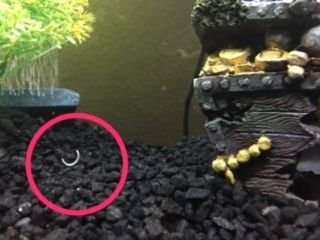Hi and welcome to the forum

Fish do a stringy white poop for several reasons.
1) internal bacterial infection causes the fish to stop eating, swell up like a balloon, breath heavily at surface or near a filter outlet, do stringy white poop, and die within 24-48 hours of showing these symptoms. This cannot normally be cured because massive internal organ failure has already occurred.
Your fish do not have this problem.
2) internal protozoan infection cause the fish to lose weight rapidly (over a week or two), fish continues to eat and swim around but not as much as normal, does stringy white poop. If not treated the fish dies a week or so after these symptoms appear. Metronidazole normally works well for this.
Your fish do not have this problem.
3) intestinal worms like tapeworm and threadworms cause the fish to lose weight, continue eating and swimming normally, do a stringy white poop. Fish can do this for months and not be too badly affected. In some cases, fish with bad worm infestation will actually gain weight and get fat and look like a pregnant guppy. This is due to the huge number of worms inside the fish.
Livebearers like guppies, mollies, swordtails & platies are regularly infected with gill flukes and intestinal worms. If the fish are still eating well, then worms is the most likely cause.
You can use Praziquantel to treat tapeworm and gill flukes. And Levamisole to treat thread/ round worms.
You treat the fish once a week for 3-4 weeks. The first treatment will kill any worms in the fish. The second, third & forth treatments kill any baby worms that hatch from eggs inside the fish's digestive tract. You do a 75% water change and complete gravel clean 24-48 hours after treatment. Do at least 2 big water changes between treatments to remove any medication.
Treat every fish tank in the house at the same time.
Do not use the 2 medications together. If you want to treat both medications in a short space of time, treat them with Praziquantel one day. Do a 75% water change and gravel clean the next 2 days. Treat with Levamisole after the second water change. Then do water changes for the next couple of days before doing the second round of treatments with the Praziquantel.
It is my opinion your fish have intestinal worms and I would treat the fish for intestinal worms before worrying about other diseases.
-------------------------
Because the tank is newly set up, you should keep feeding down to 2-3 times per week. Don't worry, the fish will not starve. You should do a 75% water change and gravel clean the substrate 4-8 hours after feeding. And you should also monitor the ammonia and nitrite levels and do a 75% water change any day you have an ammonia or nitrite reading above 0, or a nitrate reading above 20ppm.
*NB* Make sure any new water is free of chlorine/ chloramine before it is added to the tank.
Anything that breaks down in water (fish food, fish waste, dead fish, dead plant, etc) will produce ammonia. In a healthy aquarium with an established filter, this ammonia is eaten by beneficial filter bacteria and converted into nitrite. More bacteria eat the nitrite and convert it into nitrate. You get rid of nitrates by doing water changes and gravel cleaning the substrate.
In a new tank this beneficial filter bacteria has to develop in sufficient quantities before it can remove the ammonia from the water and convert it into nitrite and then nitrate. It normally takes about 4-6 weeks for the filters to develop these bacteria and until that time, you need to minimise the food and fish waste and do regular water changes to keep the ammonia levels as low as possible.
The big water changes will not harm the filter bacteria or fish as long as any new water is free of chlorine/ chloramine before it is added to the tank.
Once the filters have established you can feed the fish more often and do a 75% water change and gravel clean the substrate once a week.
-------------------------
What sort of filter do you have and did the shop tell you how and when to clean it?




